IS IT SUNNY, ENOUGH?
A Plant’s Perspective
No matter what you’re growing, and especially if you’re growing most fruits or vegetables, you need to know what “full sun” and “part shade” mean. People with shady yards often have their own definitions.
The tall trees that surrounded my father’s yard created lots of shade; he once planted a grapevine in what he called a sunny spot, which was where the leafy tree canopy spread open enough to let a ray of sunlight peek through for about an hour at 12:30. The grape vine did grow, but bore a paltry crop, and those grapes it did bear were sour.
Grapes need “full sun. “Full sun” to a plant means direct, unobstructed sunlight for at least five or six hours a day. Besides vegetable gardens and most fruit trees, many flowers also require this exposure.
Sometimes Shade is Tolerable
There are plants that are well adapted to, even need, shade in their youth, but require more sunlight as they age. Maples and beeches, for example, as well as other forest trees which start out as seedlings in the shade of existing forests, but eventually reach light and become the canopy itself.
Pawpaw, which is a forest tree native throughout the eastern part of this country, is also in this category. That applies to seedling trees, that is, trees grown from seed. But if you plant a tree of a named variety, such as Wabash or Sunflower, the stem that made that grafted tree originated from a mature mother plant. So that Wabash pawpaw tree is actually mature wood, and needs full sunlight even if only a foot tall.
(Which reminds me to remind you: Registration for my April 30th GRAFTING WORKSHOP ends April 27th at 8 pm. Information at www.leereich.com/workshops.)
Shade not only decreases flowering and fruiting of plants that need sun, but also causes their leaves and stems to become succulent. Targeted shade can be put to use in the vegetable garden. Banking soil up around celery stems, though no longer in favor, used to be done to blanche the stalks for more succulence. I blanche my endive by planting them cheek to jowl so that each endive plant pushes leaves of its neighbors over the developing inner leaves. Those inner leaves become blanched, more juicy and less bitter.
Exposure Microclimates
Full sun is downright inimical to some plants. The foliage of some ferns and house plants will burn in full sun. In other cases, shade-loving plants do not require shade per se, but the cool, humid environment of shade. Blueberries often grow wild in some shade, but — as evidenced in my garden — bear more prolifically if grown in full sun so long as their roots are kept cool with a thick mulch and the plants receive a steady supply of water.
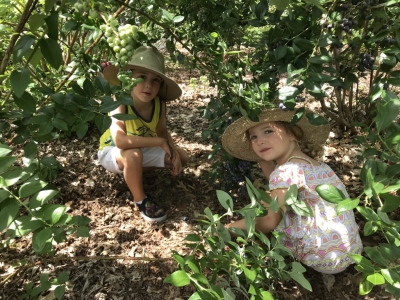
Kids take a break from picking blueberries, on the nice mulched ground
“Part shade” (or “part sun,” take your pick) occurs when a canopy of leaves or an arbor blocks the sun, or when plants are planted near enough to buildings to receive sun for only part of the day. Plants growing on the east side of walls get only morning sun, which is cool year ’round and well suited to broadleaf evergreens such as mahonia and rhododendron. Such plants would scorch against a west wall. A west wall is more suited to plants like thyme, potentilla, and santolina, which revel in the fury of late afternoon sun.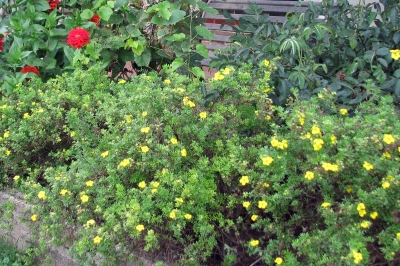
Plants shaded by north walls get a bit of early morning and late afternoon sun in summer, and diffuse light in midday. This wall will be dark in winter, but as the days get longer the sun wraps more and more around the sky, shedding more direct light on the wall early and late in the day. This effect increases with increasing latitude, which is how British gardeners get away with growing cherries, which require “full sun,” as espaliers trained on north walls. (The coolness of the north wall also delays blossoming, so the flowers have an increased chance of escaping damaging late spring frosts.)
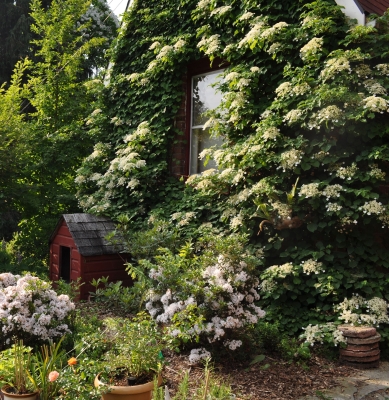
North wall of my home
A Shady Palette
No need for disappointment if you realize some of your full sun is, in fact, part shade. Plenty of plants enjoy the dappled play of sunlight through tree branches, or the coolness of northern or eastern walls. Shade-lovers are represented by every category of plants: deciduous woody plants like bush honeysuckle (Diervilla lonicera), dogwoods, and witch-hazels; evergreen woody plants like mountain laurel, rhododendron, azalea, euonymous and leucothoe; vines such as akebia, and Boston and English ivy; perennial flowers such as astilbe, bleeding heart, columbine, daisy, primrose, and violets; and annual flowers such as impatiens, begonia, and nicotiana.
Some fruit plants even bear very well in part shade. I’ve seen gooseberries as well as red, white, and black currants (that’s three different species, not one tricolor plant) bearing very well in even full shade.
Many ferns and other woodland plants are especially adapted to such full shade, as are cultivated plants like hostas, pachysandra, and vinca. To really put a spark in full shade, I’ve planted cardinal flower, one of my favorites even if their fire engine red flowers look to me like they’re showing off a bit too much for shade.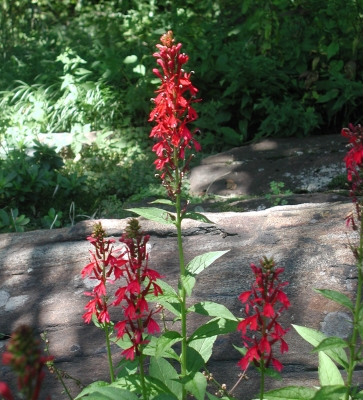
And finally, we come to spring ephemerals, herbaceous plants of deciduous woodlands that grab what sunlight they can before the branches overhead are clothed with their leafy canopy. After a few weeks their leaves and stems, having fed their roots and bulbs, dissolve back into the earth. Many, such as trillium, bloodroot, Virginia bluebells, trout lily, and Jack-in-the-pulpit, are comely natives. More familiar are spring bulbs, such as tulips, grape hyacinths, winter aconite, and daffodils, many of which are Eurasian in origin.
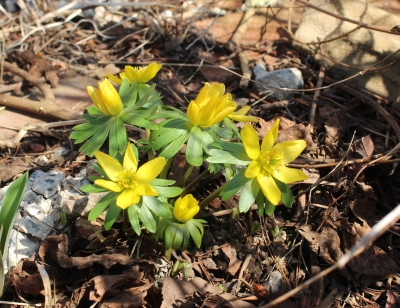
Winter aconite
Twenty-five years ago I planted a forest at the south end of my meadow, a mini-forest of three sugar maple, three river birches, hickory, and buartnut (a hybrid of our native butternut and Japanese heartnut). 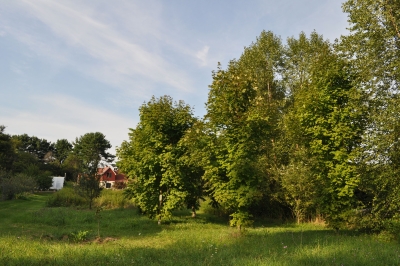 Fifty feet above the ground, the leafy canopies have woven together to create summer shade that has become home to shade lovers (humans and plants) and spring ephemerals (plants).
Fifty feet above the ground, the leafy canopies have woven together to create summer shade that has become home to shade lovers (humans and plants) and spring ephemerals (plants).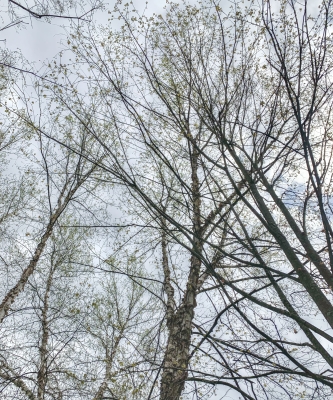 Despite what I wrote above about vegetables and full sunlight, I do grow one vegetable in my mini-forest: ramps. For the past couple of weeks and for some to come, leaves of this spring ephemeral will bring their flavor — similar to onions and garlic, but different and less potent — to the kitchen before dissolving back into the earth until next spring.
Despite what I wrote above about vegetables and full sunlight, I do grow one vegetable in my mini-forest: ramps. For the past couple of weeks and for some to come, leaves of this spring ephemeral will bring their flavor — similar to onions and garlic, but different and less potent — to the kitchen before dissolving back into the earth until next spring.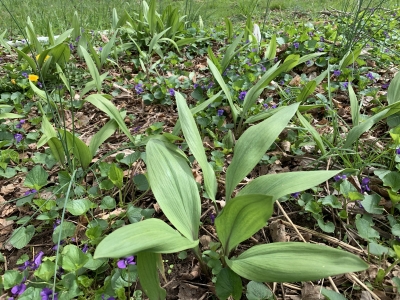



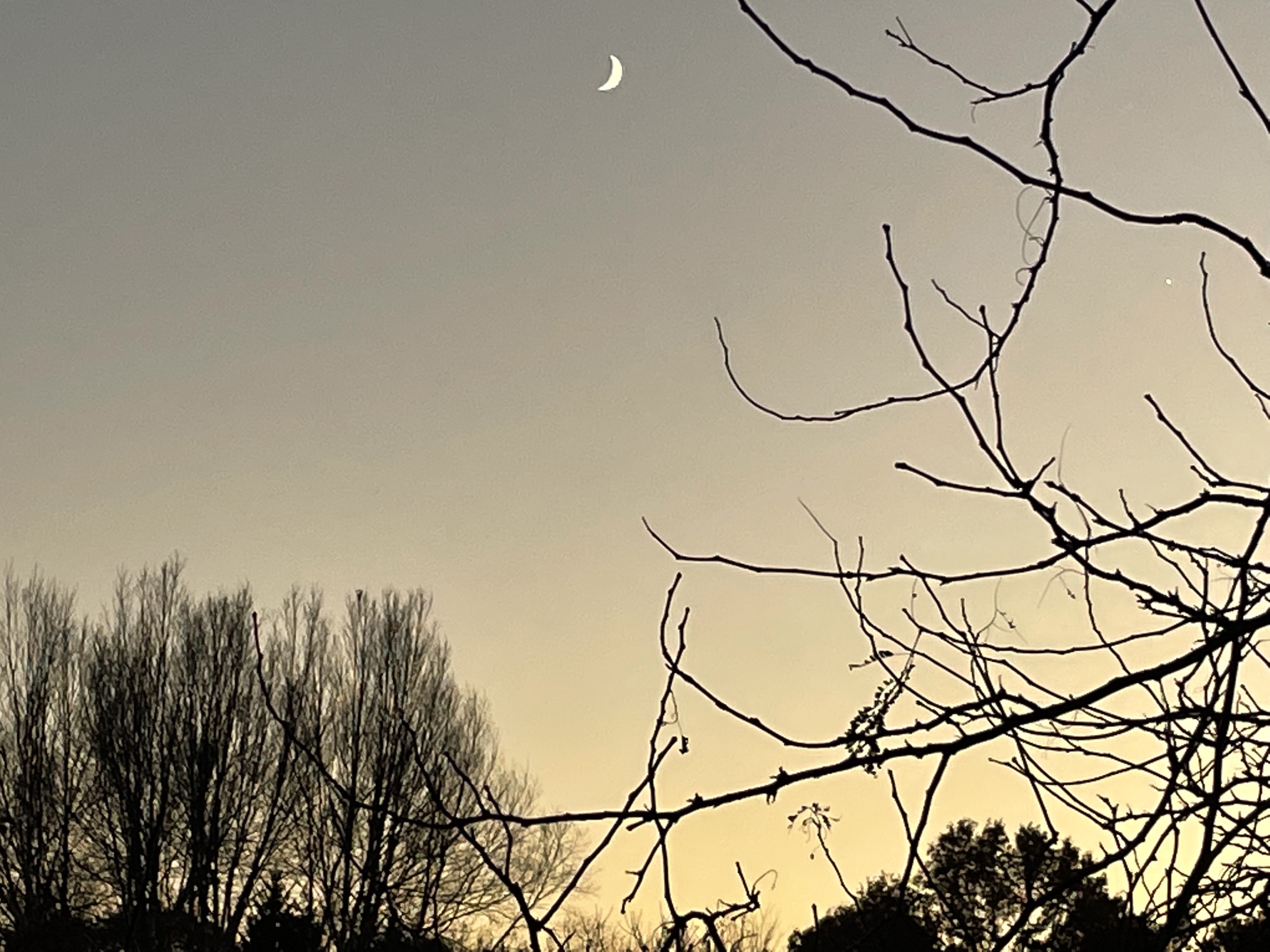
I am sad at the moment. This post enchanted me and lifted my heart! Love the children under the blueberries esp but the whole post. Thank you.
I’m glad to have helped in more ways than just horticultural.
I love seeing your blog in my inbox! Just a quick note to say you have a very big fan in Ann Arbor, Michigan and also that climbing hydrangea pic is absolutely fabulous. Thanks for making a workday a bit brighter.
I blush. Thanks.
I, too, must say that the photo of your North Wall makes me want to run out and buy some of those climbing hydrangeas. Super luscious. Thank you for the post!
Thanks.
I have a coping mechanism that hasn’t served me well, though I push on—undeterred. I look at a shady spot & think, “surely it is sunny enough to grow X (a plant that requires full sun)”….and later say, about a sunny spot, “surely this spot is shady enough to grow Y (a plant that requires shade).” And when weeding, I think that if I cut a weed back to the ground (missing the root), “surely that will be enough to kill it”. And when accidentally cutting a desirable plant the same way, think, “surely it will come back.” I’m always an optimist in the garden, yet a pretty big pessimist in life! Maybe that is what plants cultivate in me—optimism.
Interesting approach to gardening, perhaps life. If it works.
Your climbing hydrangeas look lovely!
I inherited one with my Kleingarten. It’s on a south-facing trellis, but then I’m at 54 degrees N and the area is heavily shaded on the west side. Or the previous owner liked seeing it prominently placed. 🙂
It seems to be losing its vigor. Is there anything I can do to restore it, or has it come to the end of its life? Will new plants start well from cuttings? Many thanks in advance!
Must be some other factor besides age. I think they are very long lived. Mine seem to get fighteningly stronger every year. Think of what might have changed for the worse over the years. Soil? Water? Shade? Sun? Competition?
Thanks for helping me understand that canopy of leaves will be blocking the sun or that when buildings shade the plants are called part shade. I think I like that idea for my backyard which we can use for our protection when it is summer time. We can get canvas canopies installed so that we can also get shade when the sun is too hot during that season.
Glad it helped.
thanks for info.